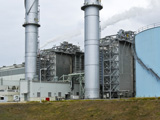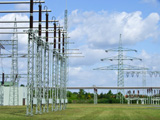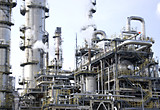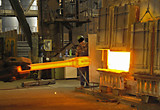
In a conventional power plant, thermal or potential energy is converted to mechanical energy, which in turn must be converted to electrical energy. A steam, gas or water turbine is used to drive a rotating shaft, which in turn drives a generator, producing electricity at a relatively low voltage (typically in the range 15kV-24kV). This low voltage must be transformed to a higher voltage using a generator step-up transformer, otherwise the transmission conductors would be too large in cross-section to be practical, and the voltage drop (typically 10kV on typical transmission line) would mean that little or no power could actually be transmitted.
The generator transformer typically consists of a low voltage winding, a high voltage winding and an optional high voltage regulating winding, to allow some control of the output voltage level.
Many of the challenges with the design of generator step-up transformers relate to the extremely high currents in the LV windings, and the magnetic fields produced by the heavy current connections. Royal SMIT Transformers B.V. takes great care to calculate and control these magnetic fields in order to avoid hotspots in either the internal clamping structures or the transformer tank.
Royal SMIT Transformers B.V. has an ongoing engineering evaluation process for continuous improvement and upgrade of its design programs.
Royal SMIT engineering is making full use of a high end 3D-CAD system for the complete transformer design. Active parts and tanks can be combined in one model allowing the best possible check on correct dimensioning.
Almost all engineers use 3D-CAD stations. The introduction of 3D-CAD technology was thoroughly prepared over the past years. A team of experts worked fulltime on the required tank- and active part models.
The great advantages for SMIT as well as its customers are:
constant quality because of modular design
large reduction of engineering time for standardised transformer designs
reduced engineering lead time for even the most complicated transformers
Royal SMIT Transformers B.V. produces large power transformers with independent clamping of the core and windings. This clamping system is unique amongst manufacturers of large power transformers.
The independent clamping arrangement has many advantages:
Royal SMIT style windings differ from most of our competitors in having axial cooling ducts without pressboard radial spacers. This type of winding style has several advantages:
Royal SMIT Transformers B.V. has developed finite element models of the transformer tank design allowing the tank stresses and vibration levels to be accurately predicted:
Reliable Transformers with the unique single winding clamping construction are shipped wordwide to customers producing power. We have extensive experience with requirements for the nuclear industry and the renewable energy. The single winding clamping construction gives additional strength regarding short circuits and does not influence the core clamping.



Large Power Transformers have been delivered for customers choosing for Transformers with a long life span, high reliability and with the approved unique single winding clamping construction.


Reliable energy supply in all production processes is of main importance for our customers. Reliable Transformers are part of this philosophy. Our Transformers have been delivered all over the world for multiple industries chosing for quality and reliability.



Short Circuit Resistance is a major concern for customers within the railway industry. That is why our Transformers are chosen, being very reliable due to the unique single winding clamping construction and the high quality of our Transformers.

